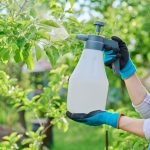Plant mulch is a barrier that is placed between the substrate and the outside, it can be an organic mulch, with bark, humus, etc., or an inorganic mulch, with stones. Its function is to protect the substrate and roots of the plant, help regulate its temperature and prevent excessive evaporation of water, among other aspects. It is a technique widely used in organic gardens.
If you have a vegetable garden, a garden or simply potted plants that you want to take care of very well, keep reading because in this article from EcologíaVerde we will see what mulching is, its types and how to use it.
What is mulch for plants and benefits
Mulching is a technique used in organic farming in which a physical barrier provides protection to the soil and prevents weeds from developing. This barrier consists of placing a layer of different materials, both organic and inorganic, on the surface of the soil, which prevents the passage of light and gives it protection against strong changes in temperature and erosion.
The benefits of mulch for plants are diverse, including:
- It hinders the growth of weeds in the orchard.
- It provides protection to the substrate and the microorganisms that inhabit it against sudden changes in temperature, winds or abundant rainfall.
- Helps maintain root heat in winter and coolness during summer.
- It helps to reduce water losses due to evaporation and shades the soil, which allows moisture to be maintained in the substrate. Therefore, mulching helps to save water in crops.
- Mulching with organic materials helps the fertility of the soil, as its elements are broken down and incorporated into the soil in the form of humus.
- It helps to increase biodiversity and biological activity present in the soil.
Learn more about Organic Farming: what it is, advantages, examples of techniques and pests in this other article from EcologíaVerde.
Types of mulch for plants and materials
There are two basic types of mulching for plants and these are organic and inorganic. Here we explain them, along with the materials to make mulch for plants:
Organic mulch
This type of mulching uses exclusively organic materials, such as peat, leaf mulch, decomposed manure, straw, compost, sawdust, bark, wood chips, or dried grass clippings. The advantage of these types of mulches is that they also provide improvements to the soil in fertility.
For example, a pine bark mulch not only protects the soils, but also acidifies them. Mulching of shredded branches of plants that are healthy and disease-free can also be used. Another way to mulch is to apply a thin layer of dry grass clippings or use the leaves that fall from deciduous trees.
Another type of organic mulching that looks great is wood chips and bark, but at least two years old, as young bark usually absorbs nitrogen from the soil when it decomposes. Another option, if we are going to use young barks, is to apply some nitrogen mineral fertilizer.
Organic mulching is always the most recommended, as they decompose and provide additional improvements to the soil, such as the supply of nutrients.
Inorganic mulch
This type of mulching uses inorganic materials, such as gravel, gravel, marble, crushed ceramics, expanded clay, volcanic rock or stones in general. However, these types of materials do not provide the improvements of organic materials. Mulching or muching made with stones is suitable on sloping terrain and around downspouts.
How to Use Mulch for Plants
It is advisable to mulch before the tree or plant begins to sprout. In this way, the new plant will take better advantage of the contribution of nutrients or the improvement in the soil that will occur. When we refer to our vegetable garden, pot or garden, the ideal is to do it at the end of winter, just before starting the crops, and we can repeat it at the end of summer. The steps to make a mulching or mulch for plants and use it correctly are:
- Remove the weeds and loosen the soil with a hoe, leaving the soil loose so that the materials and supplements we provide penetrate better.
- Add the material and distribute it in a mulch with a thickness of between 10 and 15 cm.
- Add microorganisms, which will facilitate the decomposition of organic matter and the absorption of nutrients by the plant.
- Add the nutrients that the plant needs.
- With a rake or cultivator, bury and mix the microorganisms and organic fertilizer.
- Water the crop.
This way your mulch or mulch for pots, lawns, vegetable gardens, etc. will be ready. However, you also have the option of purchasing a type of organic mulch for plants that you like. Here you can find one that we recommend.
Difference Between Substrate and Mulch
In summary, we can indicate that the substrate is the growth medium in which the roots of plants are planted, while mulch is a layer that is placed on the surface of the soil to improve its conditions, protect it, conserve moisture and provide other benefits. Both are important for successful plant cultivation, but they serve different functions in the plant growing environment.
After learning more about mulching for plants, we recommend you learn more about materials to prepare and care for plants. Here we talk about Arlite or expanded clay for plants: what it is and how to use it and Volcanic gravel for plants: what it is and how to use it.
If you want to read similar articles to Mulching: what it is, types and how to use it, we recommend that you enter our category of Garden care.










